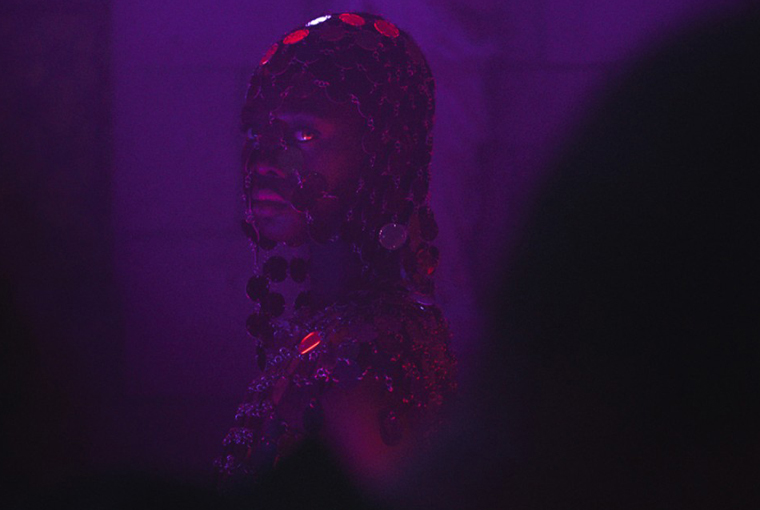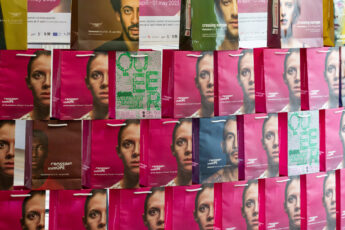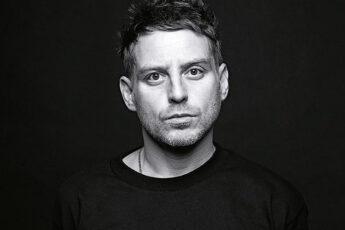
Disco Boy is a visually striking and highly stylized film that foregrounds issues of identity and belonging. Blurring landscapes and locations, director Giacomo Abbruzzese threads a narrative through the most unlikely of spaces and characters. From deep in the jungle of the Niger Delta to the streets of Paris, the filmmaker builds a world full of potential connectedness from the people we encounter. Cultures may collide, but there is a universal “sharedness” that binds us all: in the physical form of dance and also in the more abstract form of memory.
The film’s main protagonist, Aleksei (Franz Rogowski), is introduced with his best friend Mikhail (Michał Balicki) on a bus full of Belarussian football hooligans. Equipped with only a three-day visa, Aleksei and Mikhail must evade the Polish border control at a gas station. They ultimately hitchhike their way to provincial France with a long-haul truck driver. After a grueling hike through the wilderness, their journey is blocked by a river. Inflating a mattress in the pouring rain, Aleksei and Mikhail use it as a raft to swim to the other side. Thumping house music is played over the crashing of the waves, the current thrashing the mattress in the storm. Lightning strikes reflect off the water, creating a pulsing, strobe-like aesthetic. The camera hovers at water level as they kick their legs against the torrent. The sounds and visuals of the sequence create a nightmarish discotheque, where the aggression of the electronic music matches the fury of the river. When the mattress capsizes, Mikhail drowns as a sodden Aleksei barely makes it to the riverbank. Catching his breath in the darkness, Aleksei realizes he is now all alone. When he looks back to the river, Mikhail’s face is superimposed onto the water, his visage floating in time with the rippling of the waves. This trance-like cinematic experience is repeatedly used in Disco Boy. It’s an interesting way of aligning Aleksei’s ordeal with a sensory attack on the spectator. It leaves the audience in a daze, overdosed on a barrage of high-octane audio and visual stimuli.
Aleksei wanders the streets of Paris as an immigrant with no legal status. Living out of a plastic shopping bag, he misses the companionship of Mikhail. Desperate, he turns to the French Foreign Legion, where the drill sergeant professes that “here everyone has a chance”. A fully qualified legionnaire is given a passport, residency permit and the opportunity to change their name with no questions asked. It is the promise of a new life, a chance to start over. It is also an institution that offers a sense of inclusion to outsiders and misfits. For the solitary Aleksei – an orphan his whole life – the army will become like a family. A training montage puts the civilians through fitness tests and trust exercises until eventually Aleksei’s name is announced during rollcall, giving him the official passing grade. Along with a select few, these fully fledged soldiers have already built a strong team dynamic together, sharing a competitive machismo.
In Nigeria, Jomo (Morr Ndiaye) and his community of revolutionary activists long for peace. They have very relatable aspirations, dreaming of being croupiers and dancers instead of guerrilla fighters. Buried in the tropical forests sits their village, surrounded by burning industrial structures. Jomo and his sister are renowned for their impressive dance displays by the campfire. Their choreography is a blend of traditions, mixing ritualistic and modern interpretive movements. It is a hypnotizing show of athleticism that seeks to marry the old and the new with the use of the contemporary electronica soundtrack. When Jomo’s army holds a group of French trespassers hostage, Aleksei’s team is sent on a mission to retrieve them, and their worlds collide. Shot through an infrared lens, the two figures wrestle each other under water. The rainbow hues of their bodies twist and turn in the struggle, spinning in unison and merging as one until Jomo is fatally stabbed.
Back in Paris, Aleksei shows increasing signs of post-traumatic stress. Losing his grip on reality, he is distracted by recurring hallucinations of Jomo. Racked with guilt, these frightening visions cause Aleksei to act alarmingly and abuse alcohol. In killing Jomo, he has become disenfranchised once again. After he burns his legionnaires’ uniform, Aleksei returns to a nightclub to find an exotic dancer (Laëtitia Ky) that shares Jomo’s unique eye color. It is later revealed the dancer is none other than Jomo’s sister, who has left the Niger Delta since her brother’s death to become a dancer in Paris’ nightclub scene. Aleksei, as if possessed by the ghost of Jomo, re-enacts the dance of the siblings from the beginning of the film. Channeling Jomo’s prior physical performance, Aleksei liberates himself from his depressive existence through the expressive form of dance. His bodily gestures exude a kind of duality of man, bonded spiritually with Jomo as well as mimicking his muscular corporeal presence.
One interpretation of Disco Boy’s open-ended conclusion is that it is a symbolic transcendence of borders. The narrative breaks the boundaries of linearity and identity. The memory of Jomo haunts Aleksei, following him from Nigeria back to France. Jomo’s dreams of being a dancer are realized even after his death through Aleksei’s trauma and his inexplicable adoption of the dance routine with Jomo’s sister. Ironically, Aleksei and Jomo share an “otherness”, where their isolation on the margins of society is what brings them together into a singular identity by the film’s close. Abbruzzese’s feature is a uniquely feverish vision that marries an impressive soundtrack composed by French electronic music producer Vitalic and wildly experimental methods of storytelling. It is a cinematic spectacle, albeit an ideologically confused one. With the absence of a clear and concise narrative arch, Disco Boy relies heavily on the realm of the abstract, leaning on style over substance. Formally, it never ceases to be a resourceful feature, but it does so at the sake of its actual meaning. As a result, some of the film’s underlying themes are rendered inconsequential and unsupported due to the onslaught of brash cinematic techniques, leaving more of the spectator’s questions left unanswered.




Leave a Comment